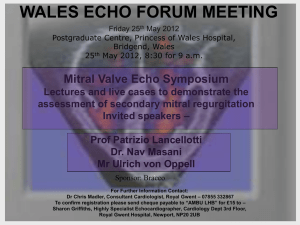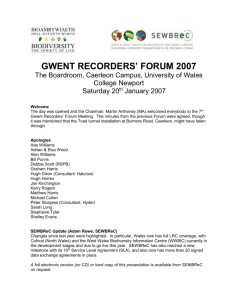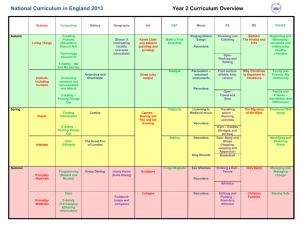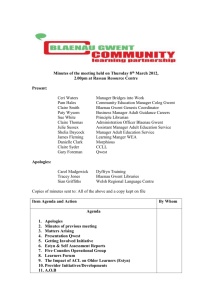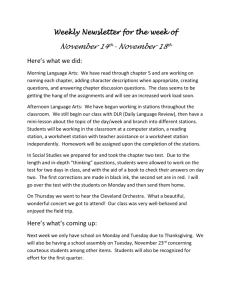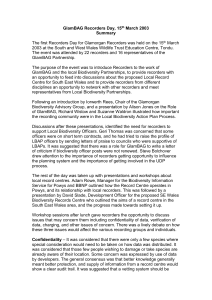WORKSHOP FEEDBACK
advertisement
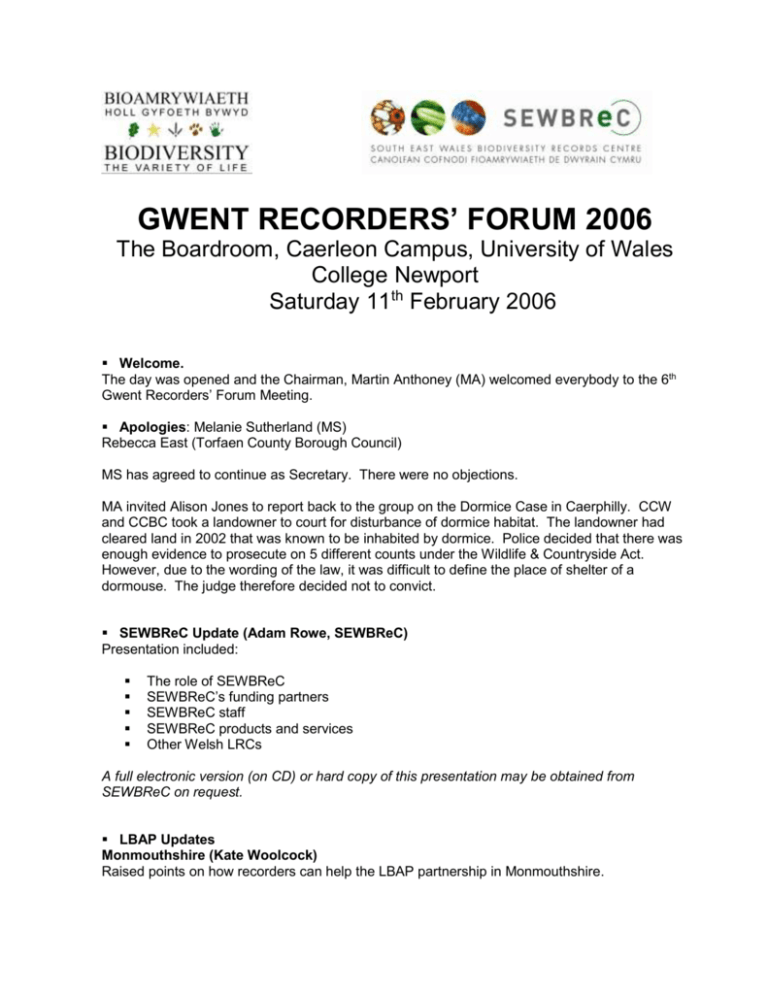
GWENT RECORDERS’ FORUM 2006 The Boardroom, Caerleon Campus, University of Wales College Newport Saturday 11th February 2006 Welcome. The day was opened and the Chairman, Martin Anthoney (MA) welcomed everybody to the 6th Gwent Recorders’ Forum Meeting. Apologies: Melanie Sutherland (MS) Rebecca East (Torfaen County Borough Council) MS has agreed to continue as Secretary. There were no objections. MA invited Alison Jones to report back to the group on the Dormice Case in Caerphilly. CCW and CCBC took a landowner to court for disturbance of dormice habitat. The landowner had cleared land in 2002 that was known to be inhabited by dormice. Police decided that there was enough evidence to prosecute on 5 different counts under the Wildlife & Countryside Act. However, due to the wording of the law, it was difficult to define the place of shelter of a dormouse. The judge therefore decided not to convict. SEWBReC Update (Adam Rowe, SEWBReC) Presentation included: The role of SEWBReC SEWBReC’s funding partners SEWBReC staff SEWBReC products and services Other Welsh LRCs A full electronic version (on CD) or hard copy of this presentation may be obtained from SEWBReC on request. LBAP Updates Monmouthshire (Kate Woolcock) Raised points on how recorders can help the LBAP partnership in Monmouthshire. Newport (Dolores Byrne) Priorities for the coming months are: re-igniting the currently dormant partnership, production of a newsletter (requested articles for inclusion in the newsletter to be published by end of Feb/beginning of March. Made a general request for recorders to get more involved in Newports’ LBAP partnership. Mentioned that there are training days for otter surveys coming up. Toad tunnel being installed at Bulmore Road, Caerleon. Will be supporting the brown hare and lapwing surveys and churchyard surveys taking place on a Gwent-wide level. Caerphilly (Alison Jones) Gave a presentation on the very successful Go Wild event which is hosted every other year (shared with Blaenau Gwent). Highly successful in terms of raising awareness of biodiversity, but also for recruiting more members and raising awareness of the various recording groups and conservation groups. Requested more involvement from Recorders’. Blaenau Gwent (Deborah Beeson) General request for more involvement from Recorders with surveys. Will be hosting Go Wild in 2006 at Parc Bryn Bach, Tredegar, 10 June 2006, 12 – 4pm during Wales Biodiversity Week. Go Wild was very successful in 2004. B.A.G.S. is proving to be very successful with many applications for grant money (also coming from outside the County Borough), and with delivering LBAP targets. 13 different projects funded so far. Will also fund survey work but they need to lead to practical action on the ground. Silurian moth caterpillar site was found last year in Blaenau Gwent. Torfaen (Kris Roberts) Trying to integrate biodiversity into the Local Development Plan (LDP). Will be updating Phase I Habitat Surveys. Designating 6 LNRs. Will use Wildlife Site to link up SSSIs and LNRs, etc thus improving wildlife corridors. MA expressed thanks to LBAP Officers for their presentations and for their hard work. RECORDERS’ UPDATES Bryophyte Recording in Monmouthshire VC (Sam Bosenquet (SB)) SB records on tetrad basis (2x2km). Often collects the specimens as that helps to verify the record. Uses an Excel spreadsheet (linked to DMAP) as finds Recorder cumbersome to use. SB explained bryophyte coverage throughout the VC. More recording taking place in certain areas particularly North West of County and also in Dingestow and Wye Valley. SB explained important habitats for bryophytes e.g. reservoirs, stone tiled roofs, arable fields; and also explained some distributions of some species. Birds of Gwent (Alan Williams) GOS are going to produce a county avifauna ‘Birds of Gwent ‘ 2nd Edition (c.500pgs) Due in Autumn 2006. GOS record within Gwent but also over to the eastern part of VC 41 up to River Rhymney. They cover 394 tetrads. The new distribution maps for the atlas will reflect true changes for example lapwing (some decline), tree sparrow (serious decline), spotted flycatcher (some decline), nuthatch (doing well). Includes additional species now on breeding list e.g. Avocet, Dartford Warbler, Little Egret, and also additions to the Gwent list e.g. Bairds Sandpiper. GOS also use spreadsheet and map using DMAP. Invertebrate Recording on Gwent Wildlife Trust Reserves (Julian Branscombe) Dr Peter Kirby carried out invertebrate survey of 13 GWT reserves. Including Brockwells Meadows, Croes Robert, Dan y Graig, Prisk Wood, Kitty’s Orchard, and Springdale Farm. A great deal of data was produced and a wide range of Red Data Book & nationally notable species were found. Julian illustrated his presentation with images of many of these rarities. Fungi Recording in Gwent (Sheila Spence) Gwent Fungus group was restarted in Spring 2005, and launched at various festivals/events. They have surveyed Coed y Cerrig NNR, The Punch Bowl, Priory Grove, Croes Robert Wood, Margarets Wood. The first record for Great Britain of Mycena amicta var iris. was found at Margarets Wood 09/10/2005. Contact gwentfungusgroup@btinternet.com 01531 631736 Fungi Recording (Shelley Evans) Draft Red Data Book List has now gone to JNCC for approval. To be published in late 2006. Review of UKBAP species has now gone to JNCC. Will be finalised shortly with around 60 species on the list. Gwent Bat Survey Project (Ian Rabjohns) Funding came from Species Challenge Fund, but arrived late in season (July) so only 2 months left of surveying. There are big holes in Gwent data – most data is not known to species level. Most records are held in the Monmouthshire LA. Of all species recorded in GB, 11 have been recorded in Gwent. Common Pipistrelle – twice the number as Soprano Pipistrelle currently, however likely to become similar numbers as more data comes in. Noctule – over 200 records Serotine – new species for area Greater Horseshoe – good numbers Lesser Horseshoe – well distributed in Monmouthshire and eastern parts of Newport. Monmouthshire is thought to have a population size of 6.5 thousand LHS, and is one of the most important sites for this species in Europe. Natterer’s – showing good numbers of records Whiskered/Brandts – difficult to separate out to species as calls are very similar Daubenton’s – connected with water courses. Long-eared bat – 18 spot records. Probably under recorded as they have quiet bat call. Next years surveys will be focused in Newport. MA – expressed thanks to all recorders and experts working in the Gwent area. Analysis of SEWBReCs’ Data Holdings (Adam Rowe, SEWBReC) Presentation included: Data Exchange Agreements; Services that SEWBReC can offer Recorders Data Management & Exchange Data Release Agreement & Sensitive Data Analysis of SEWBReCs’ Data Holdings: Distribution of various taxonomic groups e.g. birds, mammals, invertebrates Temporal distribution data Key data sets currently held Other known data sets Closing thoughts A full electronic version (on CD) or hard copy of this presentation may be obtained from SEWBReC on request. WORKSHOPS The workshop sessions considered: Are there additional datasets that SEWBReC may not be aware of? Are there any barriers (perceived or actual) to data sharing with SEWBReC? What steps should be taken (and by whom) to start the process of filling these gaps? The future of the species subgroups Species subgroup: Birds Co-ordinator: Jerry Lewis Gaps in the data set - it was clear that the bird data set was the least complete of any, and this was mainly because the substantial information held by the Gwent Ornithological Society had not been made available to SEWBREC. However, at a Committee meeting of GOS earlier in the week it was agreed in principle to enter a Service Level Agreement, and a sub-group was set up to discuss the details of the agreement. Information which would be potentially handed over were the digitised distribution of breeding birds (from the new Birds of Gwent publication), and non digitised data from the records submitted to the Society annually (and going back some 20 years). Other data sets that were probably worth investigating were those held by the RSPB, BTO, WWT and individual recorders who do not submit their data to GOS. Future role of the bird group - the bird group is still probably more advanced than the other species groups, as most of the important bird species in Gwent now have a Species Action Plan available to guide production of a local version (although 3 or 4 species plans have not yet been written). It was suggested that the Group could provide information for the individual LBAPs during their review of existing bird SAPs, or help with the production of new bird SAPs. Species subgroup: Plant, Lower Plants & Fungi Co-ordinator: Colin Cheesman Filling the Data Gaps Many national organisations have Gwent records – British Mycological Society and British Lichen Society. BMS is reputed to have 2,000 records for Gwent. Many individual recorders have records that are not in the database – Shelley Evans has about 3,000 – 4,000 records for Gwent CCW have co-ordinated surveys e.g. for waxcaps that presumably will be picked up during SEWBReC’s contracts to computerise CCW data Therefore need to approach all national bodies for records and individual recorders This needs to work both ways so that official Gwent Recorders for any particular group are sent records for verification. Only 2 Atlas’s were ‘on the go’ with Trevor Evans pulling together the flora and Sam Bosanquet about 5 years away from a moss and liverwort flora. For data deserts, suggestions included: Organising specific groups of recorders to visit data deserts e.g. the Gwent Fungi Group could visit areas if access and parking were arranged. Organising multi disciplinary ‘hit squads’ where experts are paid to cover costs, mainly travelling, so that obviates the need for using consultant surveyors. Hold a Recorders Day in the summer/autumn in a data desert. Hereford organised such a day at a farm that was very successful. For Species or habitats Use the website / LBAP officers to target specific under recorded species or habitats possibly combined with events. General One off records are fine and just as valuable as large datasets. People should be encouraged to send in individual records – leaflet? People need to know where to send records and what’s going to happen to them. SEWBReC needs to address the issue of how it’s going to promote itself to the public as well as more specialised audiences such as recorders, local authorities, voluntary sector, consultants and statutory undertakers. Specific Historical surveys – Gwent Woodland Survey 1977; West Gwent Upland Survey 1981 (?); Gwent Upland Open Water Survey 1981, NCC Commons survey (with CCW?) Surveys as part of development e.g. EIA studies, Heads of the Valleys Road, Gas Pipelines, etc. Elsa Woods has some fungi records especially Silent Valley LNR Colin Titcombe covers a wide range of groups and would have extensive records The Wye Valley AONB office is likely to have some records for Gwent Many records are lost on the death of the recorder. For example Grant Herbert who had birded in the Heads of the Valleys area for years died recently (and tragically young too) but his records have never been recovered. Recorders need to send their records in and/or bequeath them so that the data will not be lost. Finally I (CC) personally still think there’s some mileage in an online recording system- a virtual record centre if you like. The future of the sub-group The members thought that it was a useful group and should be continued. In order to work better I have volunteered to set it up as an e-Forum so that we can communicate outside of the Recorder Day (Except for Trevor Evans! who’ll have to have stuff posted to him). LBAP officers would also have access to this e-Forum so that they could use the expertise of the group in species and habitat management and in redrafting LBAP’s. This is because individual experts and recorders can’t get to every Biodiversity Partnership meeting in Gwent. The e-Forum would also be used to put in a submission for Species Challenge when it is announced. Species sub-group: mammals Co-ordinator: Deb Beeson (standing in for Melanie Sutherland) Additional Datasets Tap into national datasets e.g. Mammal society e.g. Great Nut Hunt, Water shrew surveys, Polecat surveys (Vincent Wildlife Trust) Cardiff University (Department of Bio-sciences) Bristol University – research carried out on brown hare, fox, bats ‘WildCRU ‘ (Wildlife Conservation Unit)– Oxford University. Various surveys Dan Forman (Swansea University) – Water voles Consultants Reports Peter Smith (VC35 Mammal Recorder) Environment Wales (help facilitate Community Surveys) Barriers to Data Sharing Protected species i.e. bats, badgers are considered to be sensitive records. There is reluctance by local groups to give them to SEWBReC. Need strong confidentiality clauses. Individual recorders knowledge of SEWBReC system i.e. recorders need to be aware that SEWBReC is up and running and their records have been passes onto them. Where records have been obtained illegally without the landowners permission (i.e. trespass) there maybe reluctance by Recorder to pass information on. SEWBReC offer good services to local recorders but how many recorders take up these services e.g. Help with mapping etc Recorders are cautious as no advice/interpretation can be given with records i.e. Intimate knowledge of taxa behaviour and ecology e.g. Bat crossing points over roads. Future Role of sub-group Closer links with sources of funding – species challenge Co-ordinating Gwent wide surveys e.g. Reptiles Species subgroup: Invertebrates Coordinator: Alison Jones Perceived Barriers Data Exchange Agreement help to resolve fears many invertebrate recorders are not affiliated to group possible use of validation officers/ recorders Gaps in Database Biodiversity blitz – for geographical gaps or taxonomic gaps Need to contact individuals to tap into large data sets outside usual groups e.g. John Harper, Chris Owen, Colin Titcombe, Ray Armstrong, Deceased Recorders – Neil Horton, Derek Upton. Newsletter – asking for records Graduate and post graduate projects Wildlife Fairs Pass out SEWBReC Recording Forms at Wildlife Walks Future Role of the Subgroup Organise a field meeting Encourage non experts to take digital photos or collect samples and send to SEWBReC. MA expressed thanks to Adam Rowe and SEWBReC team for organising the event, Local Authorities for contributing money, and everybody for attending the event.
